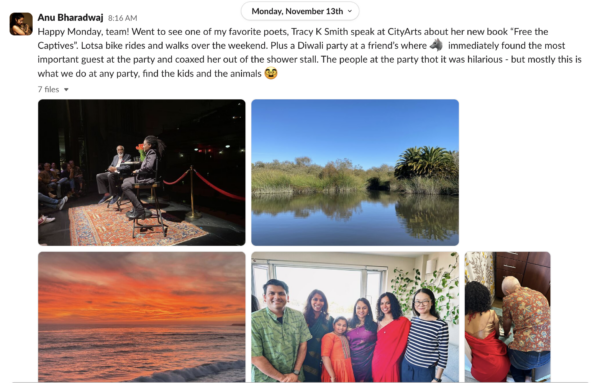How to embrace the human side of leadership
Anu Bharadwaj, President of Atlassian, shares the hard-won lessons that help her foster connectedness on her teams in a distributed world.
As humans, we’re hardwired to find purpose in what we do and act in a way that’s aligned with our personal values. Psychologist Leon Festinger talks about cognitive dissonance – a tension that occurs when our internal beliefs don’t match our lived experience. When this happens, we do everything we can to get rid of the dissonance. At work, this could mean disconnecting, burning out, or quiet quitting.
Our job as leaders is to find a way to rally our teams around a common purpose. But the best leaders go the extra mile, also finding ways to help their teams connect their work to their personal values. The real magic happens when we can connect our work with our personal values and a greater purpose. By working on something we truly believe in, we’ll find the energy to go the distance at work.
After a lot of trial and error, here are some lessons I’ve learned about how to authentically embrace the human side of work to deepen my connections with my team.
How personal values shape leadership
Organizations typically focus on embracing company values, but personal values are often overlooked. Most things start from within, so before you lead a team, you first have to understand yourself.
Six years ago, I’d come to a point in my career where I felt like I’d done it all. I had been in tech for 12 years, we’d recently taken Atlassian public, and I felt called to do something radically different with my life. I couldn’t put my finger on it at the time, but in hindsight, what I needed was a reset, a reconnection to my values.
When I confessed this to my boss, he reacted with empathy and encouraged me to take the time I needed to grow – while making it clear that I would always be welcome back at Atlassian – and taught me a valuable lesson in leadership.
I took a year-long sabbatical to volunteer for a bunch of wildlife conservation projects. I rescued lions in South Africa, collared cheetahs in Namibia, and hand-raised endangered birds in New Zealand. Then, feeling refreshed, I returned to Atlassian ready for a new challenge, finding myself wearing different hats in Product, Operations, and eventually as President of the company.
So what does a passion for saving animals have to do with the skill of leading teams? Quite a bit, actually.
During my sabbatical, the “aha” moment came when I realized the key to professional fulfillment is finding a way to align those values with your daily work. Since then, I regularly run a personal values exercise with my teams. This exercise is designed to help anyone identify the values that matter the most to them – these are the same values that show up for me at home, and also guide me as a leader.
Here’s how my “top three” values show up in my work:
- Courage: In business, courage means playing to win, not just to avoid losing. It means taking calculated risks and approaching uncertainty with strength, leading with love rather than fear. Personally, it means not being afraid to admit where I fall short, when I’m wrong, or when I don’t know something.
- Integrity: Integrity isn’t just honesty; integrity is not having to fragment different aspects of my being, bringing my whole self to what I do. Integrity is when my head, heart, and hands are all in harmony, matching what I say with what I think and how I act. This means striving to be open and transparent, even in tough situations.
- Service: Great product people put serving customers at the center of everything they do. My greatest satisfaction comes from knowing how the work I do serves our customers, our teams, our partners, our shareholders. This sense of satisfaction from service is also what leads me to carve out time for volunteering.
After we go through the values exercise, we have an open discussion to share our findings and discuss how our top values manifest in both our personal lives and at work. This practice helps deepen connections among teammates while also serving as a powerful reminder that we are all unique human beings. I find this does wonders for fostering empathy within the team.
Putting it into practice for distributed teams
It can be hard to foster connectedness even when teams are all working from the same office. With a distributed workforce, this challenge compounds. Since Atlassian started Team Anywhere in 2020, we’ve been experimenting with practices that drive meaningful collaboration, no matter where your team sits.
Here are a few tactics I use with my own teams:
- Meaningful asynchronous communication: This means using the right tools and channels – whether that’s a Confluence page or a Loom recording – to collaborate in a timezone-agnostic and inclusive way. Teams can consume content on their own time and in the format that works for them
- Sharing your weekend photos: This is a practice I do with my team over Slack. It’s an easy way for us to learn about who we are as people and to inject a bit of fun into our everyday work. My weekend photos often feature my cats, nature, and kickboxing.
- Weekly Loom videos: It’s essential for distributed leaders to have consistent touchpoints with their teams. Each week, I share a Loom video highlighting what’s top of mind for me and our upcoming priorities. I’ve found that short, casual videos really resonate – almost everyone watching stays for the entire video.
- Writing culture: Confluence is the heartbeat of Atlassian. We share what’s happening in the form of blog posts, strategy documents, and project trackers, and follow each other’s feeds to see what everyone’s working on.
- Being intentional about time spent together: Synchronous time is really precious in a distributed world. My team prioritizes in-person time for impactful collaboration, like quarterly offsites for strategy sessions and team bonding. We also have themed monthly get-togethers in our offices for people to socialize. When I travel to another city, I try to plan social gatherings with local Atlassians. It’s all about striking a balance between work and play when you come together.
- Championing vulnerability: If we want our people to be vulnerable – a key component of a psychologically safe work environment – it’s important to lead by example. Every year, I share my personal development plan with my team, which includes how my team should work with me and my areas of growth. To model that vulnerability, sometimes you have to go first.



Leaders play a major role in surfacing, understanding, and balancing individual values on our teams. When we acknowledge and embrace the messiness that comes with being human, each of us with a desire for shared community and purpose, we’re one step closer to unleashing the full potential of our teams and the teams we serve. I hope you find these tips useful as you embark on the journey to uncover a deeper level of connection with your teams.












































